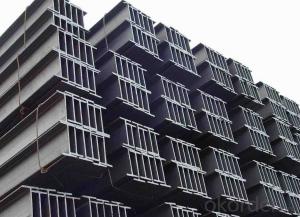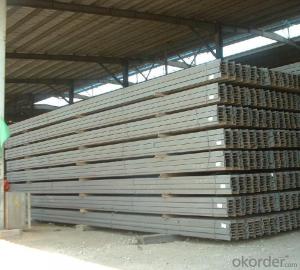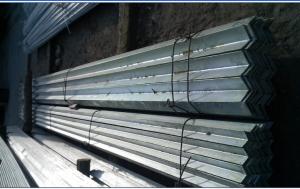IPE/IPEAA Beam Steel
- Loading Port:
- Tianjin Port, China
- Payment Terms:
- TT or LC
- Min Order Qty:
- 25MT m.t.
- Supply Capability:
- 10000MT m.t./month
OKorder Service Pledge
OKorder Financial Service
You Might Also Like
Specifications of IPE/IPEAA Beam Steel
1. Product name: IPE/IPEAA Beam Steel
2. Standard: EN10025, GB Standard, ASTM, JIS etc.
3. Grade: Q235B, A36, S235JR, Q345, SS400 or other equivalent.
4. Length: 5.8M, 6M, 9M, 10M, 12M or as your requirements

|
Section |
Standard Sectional Dimensions(mm) | ||||
|
|
h |
b |
s |
t |
Mass Kg/m |
|
IPE80 |
80 |
46 |
3.80 |
5.20 |
6.00 |
|
IPE100 |
100 |
55 |
4.10 |
5.70 |
8.10 |
|
IPE120 |
120 |
64 |
4.80 |
6.30 |
10.40 |
|
IPE140 |
140 |
73 |
4.70 |
6.90 |
12.90 |
|
IPE160 |
160 |
82 |
5.00 |
7.40 |
15.80 |
|
IPE180 |
180 |
91 |
5.30 |
8.00 |
18.80 |
|
IPE200 |
200 |
100 |
5.60 |
8.50 |
22.40 |
|
IPE220 |
220 |
110 |
5.90 |
9.20 |
26.20 |
|
IPE240 |
240 |
120 |
6.20 |
9.80 |
30.70 |
|
IPE270 |
270 |
135 |
6.60 |
10.20 |
36.10 |
|
IPEAA80 |
80 |
46 |
3.20 |
4.20 |
4.95 |
|
IPEAA100 |
100 |
55 |
3.60 |
4.50 |
6.72 |
|
IPEAA120 |
120 |
64 |
3.80 |
4.80 |
8.36 |
|
IPEAA140 |
140 |
73 |
3.80 |
5.20 |
10.05 |
|
IPEAA160 |
160 |
82 |
4.00 |
5.60 |
12.31 |
|
IPEAA180 |
180 |
91 |
4.30 |
6.50 |
15.40 |
|
IPEAA200 |
200 |
100 |
4.50 |
6.70 |
17.95 |
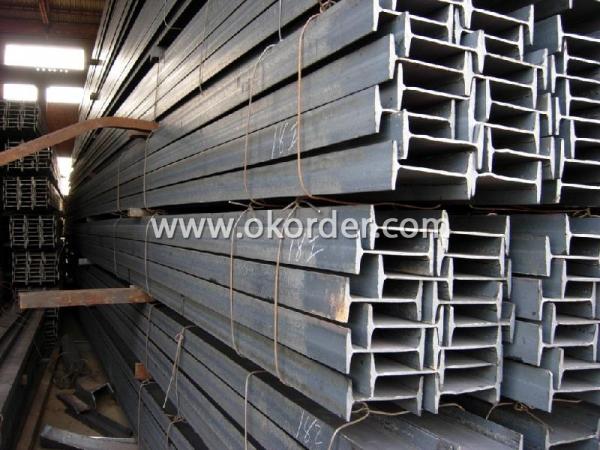
Applications of IPE/IPEAA Beam Steel
IPE/IPEAA Beam Steel are widely used in various construction structures, bridges, autos, brackets, mechanisms and so on.
Packing & Delivery Terms of IPE/IPEAA Beam Steel
1. Package: All the IPE/IPEAA Beam Steel will be tired by wire rod in bundles
2. Bundle weight: not more than 3.5MT for bulk vessel; less than 3 MT for container load
3. Marks:
Color marking: There will be color marking on both end of the bundle for the cargo delivered by bulk vessel. That makes it easily to distinguish at the destination port.
Tag mark: there will be tag mark tied up on the bundles. The information usually including supplier logo and name, product name, made in China, shipping marks and other information request by the customer.
If loading by container the marking is not needed, but we will prepare it as customer request.
4. Shipment: In containers or in bulk cargo

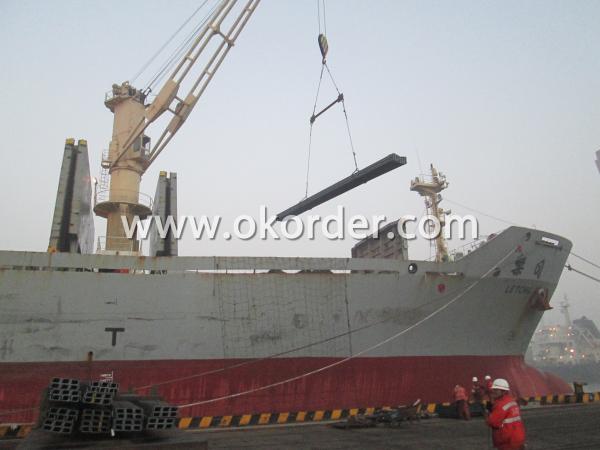
5. Delivery time: All the IPE/IPEAA Beam Steel will be at the port of the shipment within 45 days after receiving the L/C at sight ot the advance pyment.
6. Payment: L/C at sight; 30% advance payment before production, 70% before shipment by T/T, etc.
Production flow of IPE/IPEAA Beams
Material prepare (billet) —heat up—rough rolling—precision rolling—cooling—packing—storage and transportation
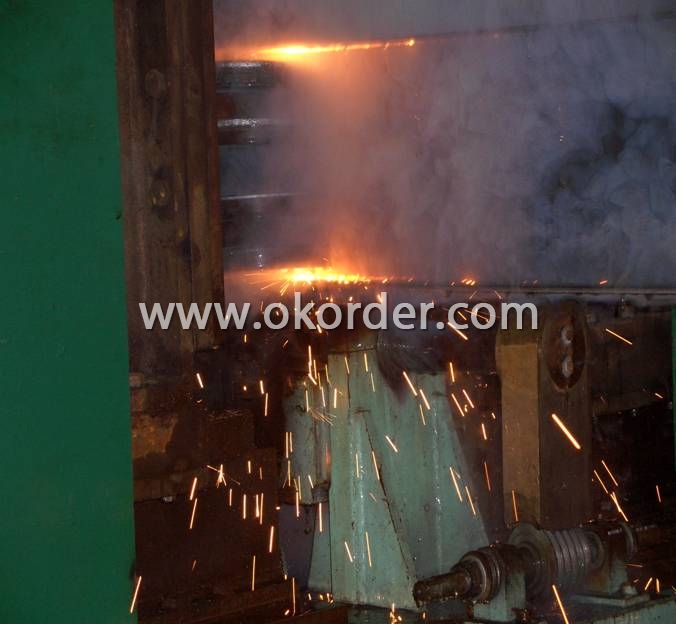
- Q:Can steel I-beams be used in retail or commercial buildings?
- Retail or commercial buildings can indeed make use of steel I-beams. The construction industry frequently employs steel I-beams due to their exceptional strength, durability, and versatility. These beams offer essential structural support and are capable of withstanding substantial loads and stresses, rendering them suitable for expansive retail or commercial structures. In addition, steel I-beams facilitate open and flexible floor plans, thereby enabling the creation of capacious and customizable retail or commercial spaces. Moreover, steel I-beams possess fire-resistant properties and a high resistance to pests, thereby making them a dependable option for commercial edifices. All in all, the structural integrity, design flexibility, and long-term cost-effectiveness of steel I-beams render them a highly favored choice for retail or commercial buildings.
- Q:How are steel I-beams protected against moisture?
- Steel I-beams are protected against moisture through various methods such as galvanizing, application of protective coatings or paints, or by using moisture-resistant materials during construction.
- Q:What are the tensile, shear, Xu Yun, and Xu Yun deflections of 20a I-beam?
- Standard design of steel structure is the total probability method, the design strength of Q235 steel plate is 215N/mm2 tensile shear stress, the load is 125N/mm2, the situation is not clear when don't use this!
- Q:What is the maximum deflection allowed for a steel I-beam?
- The maximum deflection allowed for a steel I-beam is typically determined by industry standards and building codes. These standards vary depending on the specific application and type of structure being constructed. However, as a general guideline, the maximum deflection allowed for a steel I-beam is often limited to a ratio of L/360 or L/240, where L represents the span length of the beam. This means that the maximum deflection of the beam should not exceed 1/360th or 1/240th of the span length. By imposing this maximum deflection limit, it ensures that the structural integrity and stability of the beam are maintained, preventing excessive bending or sagging that could compromise the safety and performance of the structure. It is important to consult the relevant building codes and standards applicable to the specific project to determine the exact maximum deflection limits for a steel I-beam.
- Q:What are the common design software used for steel I-beam analysis?
- There are several commonly used design software programs for steel I-beam analysis. Some of the most popular ones include: 1. STAAD.Pro: This software is widely used for structural analysis and design, including steel I-beam analysis. It offers advanced modeling capabilities, finite element analysis, and comprehensive design features. 2. ETABS: This software is primarily used for building analysis and design but can also be used for steel I-beam analysis. It provides powerful tools for analyzing and designing steel structures, including I-beams. 3. SAP2000: Another popular software for structural analysis and design, SAP2000 also includes features for steel I-beam analysis. It offers a user-friendly interface and advanced analysis capabilities. 4. Tekla Structures: This software is primarily used for building information modeling (BIM) and is widely used in the construction industry. It includes tools for detailed modeling, analysis, and design of steel structures, including I-beams. 5. RISA-3D: RISA-3D is a versatile software program used for structural analysis and design. It offers comprehensive analysis and design capabilities for steel structures, including I-beams. These are just a few examples of the commonly used design software programs for steel I-beam analysis. The choice of software depends on factors such as project requirements, user preference, and the specific design needs of the steel I-beam structure.
- Q:What are the fire protection measures required for steel I-beams in certain applications?
- Fire protection measures required for steel I-beams in certain applications typically include the application of fire-resistant coatings or the use of fire-rated enclosures to prevent structural failure and maintain the integrity of the beams during a fire. Additionally, fireproofing materials such as gypsum-based boards or intumescent paints can be used to insulate the steel beams and delay their exposure to high temperatures. The specific fire protection measures depend on the building codes and regulations, as well as the fire rating requirements for the particular application.
- Q:What are the considerations for steel I-beam design in earthquake-prone areas?
- Several key considerations must be taken into account when designing steel I-beams for earthquake-prone areas to ensure the structural integrity and safety of the building during seismic events. 1. Adherence to Seismic Design Codes: The first priority is to comply with the specific seismic design codes and regulations for the region. These codes provide guidelines and requirements for the design, construction, and performance of structures in earthquake-prone areas. It is crucial to follow these codes to ensure the building's resistance to seismic forces. 2. Careful Material Selection: The type and quality of steel used in the I-beams significantly impact their performance during an earthquake. It is typically preferred to use high-strength steel with good ductility as it can absorb and dissipate energy during seismic shaking. Additionally, the steel should have good corrosion resistance for long-term durability. 3. Precise Beam Sizing and Configuration: The size and configuration of the I-beams must be carefully determined to withstand the anticipated seismic forces. Generally, larger-sized beams with deeper sections are more effective at resisting lateral loads. The spacing and connections of the beams should also be designed to ensure proper load distribution and stability. 4. Incorporation of Ductility and Redundancy: Designing I-beams with adequate ductility is crucial in earthquake-prone areas. Ductile materials can deform without failure, absorbing energy and indicating potential structural damage. Adding redundancy to the beam system, such as multiple interconnected beams, can enhance overall structural integrity and reduce the risk of collapse. 5. Thorough Seismic Load Analysis: A comprehensive seismic load analysis should be conducted to determine the expected forces and accelerations that the I-beams will experience during an earthquake. This analysis considers factors like the building's location, soil conditions, and potential seismic activity intensity. It aids engineers in sizing the beams and designing the necessary connections and supports to resist these forces. 6. Meticulous Connection Design: The connections between the I-beams and other structural elements, like columns and foundations, must be carefully designed to ensure proper load transfer and flexibility. Special attention should be given to the connection's ability to accommodate beam movement during seismic events without compromising the overall stability of the structure. 7. Emphasis on Quality Control and Inspection: Regular quality control and inspection throughout the fabrication, installation, and construction phases are crucial to ensure correct manufacturing and installation of the I-beams. This includes verifying the steel's strength, checking for proper welding, and inspecting the connections for any defects or deficiencies that could compromise the beams' performance during an earthquake. By considering these factors during the design of steel I-beams for earthquake-prone areas, engineers can create structures that are better equipped to withstand seismic forces and ensure the safety of occupants during earthquakes.
- Q:Can steel I-beams be used for rooftop equipment supports?
- Yes, steel I-beams can be used for rooftop equipment supports. Steel I-beams are commonly used in construction for their high strength and load-bearing capabilities. They provide a sturdy and durable option for supporting heavy equipment on rooftops. Additionally, steel I-beams can be easily customized and fabricated to meet specific requirements, making them a versatile choice for rooftop equipment support systems. However, it is important to ensure that the structural integrity of the building can handle the additional weight and that proper engineering calculations are performed to determine the appropriate size and configuration of the steel I-beams to safely support the rooftop equipment.
- Q:Are steel I-beams susceptible to corrosion?
- Yes, steel I-beams are susceptible to corrosion.
- Q:What is the difference between I-beam and H steel?
- I like the name suggests, is a kind of I-shaped section steel flange on the inner surface of slope is generally 1:6, the flange and the thickness of thin, resulting in two main characteristics of I-beam section plane is huge, just to play strength characteristics in the application. Although there has been a thicker I-beam on the I-beam market, the structure of I-beam has decided its torsional performance.
1. Manufacturer Overview |
|
|---|---|
| Location | Tangshan, China |
| Year Established | 2009 |
| Annual Output Value | Above US$ 230 Million |
| Main Markets | Mid East; Southeast Asia; Korea |
| Company Certifications | ISO 9001:2008; |
2. Manufacturer Certificates |
|
|---|---|
| a) Certification Name | |
| Range | |
| Reference | |
| Validity Period | |
3. Manufacturer Capability |
|
|---|---|
| a)Trade Capacity | |
| Nearest Port | Tianjin; |
| Export Percentage | 81% - 90% |
| No.of Employees in Trade Department | 21-50 People |
| Language Spoken: | English; Chinese; |
| b)Factory Information | |
| Factory Size: | Above 500,000 square meters |
| No. of Production Lines | 1 |
| Contract Manufacturing | OEM Service Offered; |
| Product Price Range | Average |
Send your message to us
IPE/IPEAA Beam Steel
- Loading Port:
- Tianjin Port, China
- Payment Terms:
- TT or LC
- Min Order Qty:
- 25MT m.t.
- Supply Capability:
- 10000MT m.t./month
OKorder Service Pledge
OKorder Financial Service
Similar products
New products
Hot products
Hot Searches
Related keywords











